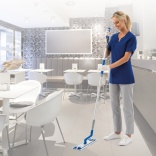Home › magazine › latest news › Why use a mop?
Why use a mop?
7th of October 2025Now that smart solutions are becoming increasingly prevalent in the cleaning sector, what are the arguments for using a manual mop - with all its associated labour costs - over a mechanised or automated solution? ECJ looks at the advantages of traditional mops and asks industry players whether they feel these can ever be fully replaced by machinery.
THE CLEANING INDUSTRY is undergoing a revolution. Technological solutions are becoming increasingly prevalent and there is a greater focus on robots, cobots and artificial intelligence at every turn.
So where does this leave the humble mop? Is there still a place for the decidedly low-tech solution of pushing a pad on a stick across the floor in today’s increasingly automated industry?
Traditional manual processes are no longer sufficient to meet today’s growing demands on their own, according to Kärcher’s product manager for manual tools Jennifer Majcher. “Machines and smart tools help to improve cleaning quality and efficiency while also easing the burden on staff,” she said.
“But the real strength lies in combining the best of both worlds.”Machines are ideal for use in large, open spaces while manual tools excel for quick interventions and for detailed cleaning in constricted areas, she says. “The choice of tool will depend on the surface, the level of soiling and the specific task.”
Majcher believes it is a common misconception that labour costs and health risks become higher when using manual methods compared with machines. “In fact modern manual mopping systems are designed specifically to reduce physical strain and improve operator safety,” she said: “Today’s systems use lightweight materials, height-adjustable handles and ergonomic designs to minimise back and joint stress.
Constricted areas
“Manual mops also shine in constricted areas such as on staircases and under furniture as well as on vertical surfaces. And they require no power, minimal maintenance and very little training which makes them ideal for flexible, low-cost use in a wide variety of environments. Manual cleaning isn’t outdated – it has simply evolved.
”Mops are a good solution for on-the-spot applications and quick clean-ups, adds Majcher. “Using a machine for a small spill is often impractical because it takes time to set up, move and operate,” she said. “A mop is faster, simpler and more precise. And mops are also ideal for quick response situations in high-traffic areas.”
Kärcher’s Kit Ray spray extraction mop system has an integrated water reservoir in the handle to allow cleaners to quickly react to spills without the need for extra equipment. The company’s Infinity system is made from aluminium and features a rotating, S-shaped frame designed to reduce the need for wrist movement while supporting a natural mopping motion.
There are several other arguments for using a manual mop, according to Majcher. “Mops offer power independence because they can be used anywhere and anytime – even in locations where there is no electricity,” she said. “They need little storage and are perfect for use by mobile teams and in tight spaces. And when used with microfibre pads they can significantly reduce water and chemical consumption.”
Practical and adaptable
Mops also incur low acquisition and maintenance costs, she adds. “In short they are practical, adaptable and sustainable and are ideal for crowded, irregular or delicate environments,” she said.
Manual mops are evolving and today’s systems are all about innovation and ergonomics, she said. “For example, hook-and-loop mop pads can now be attached almost touch-free, particularly with the aid of accessories such as our Flexobox. This is integrated into our Flexomate trolleys and allows pads to be picked up directly with the handle and then sealed using the foot.
”Smart solutions are undoubtedly gaining ground in the industry, says Filmop’s business development manager Paolo Scapinello. “However, that does not mean to say they are always the best choice,” he said. “For example, machines can facilitate the cleaning of large areas but may not be the best solution for small to medium-sized spaces or for areas that feature many obstacles. And operational efficiency is not only measured in the number of square metres cleaned per hour, but
also in the ability to adapt to different contexts and appropriately respond to specific needs.
”Flat mopping systems are a flexible solution that can meet every need, he claims. “They are compact and easy to handle and allow access even to the most confined and cluttered spaces,” he said. “They also reach every corner and allow you to easily clean walls and ceilings.
”Flat mop systems are ideal for quick clean-ups and localised interventions, he says. “It can be inconvenient to use a machine in a crowded room or in a confined space,” explained Scapinello.
Filmop’s Drop dispenser handle allows the user to dose the cleaning solution according to the surface to be cleaned and the degree of dirt. The company also offers the ErgoSwing which is designed to help prevent occupational injuries.
Flat mopping systems offer a number of other advantages, says Scapinello. “For example, they allow you to clean difficult-to-reach areas to ensure a thorough clean of the entire premises,” he said. “Their compact size is also an advantage since they can be stored in small storerooms. And unlike machines they require no electricity nor batteries and can be used anywhere and at any time without depending or the availability of power outlets or concerns about charging times.”
He says manual equipment is becoming increasingly sophisticated. “Adjustable handles, non-slip grips, quick installation systems and touch-free mop-release mechanisms are just some of the improvements that allow the operator to achieve excellent results on several fronts,” he said. “And the introduction of increasingly high-performance yarns has exponentially increased the effectiveness of dirt collection and the removal of viruses and bacteria.
”An increasing number of businesses are recognising the value of automated tools as technology becomes more accessible, says Robert Scott’s sales director Alastair Scott. “As we move through the early adopters’ stage, prices are becoming more affordable and products more effective,” he said.
Little training
“In addition, the increasing availability of robust performance data is allowing for more clarity regarding automated systems. For example, trials of our MS60 robotic scrubber dryer show that it can clean a sports hall almost three times more quickly than a human using a standard machine scrubber. And the data also reveals that automated solutions can be more cost-effective than traditional methods, particularly for labour-intensive tasks.”
However, manual mops are ideal when a speedy response is needed, he says. “Robotic tools are continuing to improve in this aspect but mops currently lead the way for on-the-spot cleaning,” said Scott.“Mopping systems have other advantages, too: they are a versatile and convenient solution for everyday cleaning and an ideal choice in more confined areas and where obstacles are present. There is also a huge variety of mop sizes and weights that can boost efficiency such as socket mops for smaller areas and Kentucky mops for larger spaces.
”Mops are lightweight, easy to operate and require very little training to use effectively, says Scott. “There is little or no down time when using most traditional mops which means they can be used repeatedly by replacing the mop head or microfibre pad to optimise cleanliness and hygiene throughout the day,” he said.
According to Scott, traditional mops are an important tool to be used alongside machines. “For example they are particularly useful if the space includes stairs or different floor surfaces, or where there is furniture to navigate,” he said. “Mops also have the added benefit of lower upfront and ongoing costs, which is an important consideration for businesses looking to keep expenditure down.
”Standing the test of time
He claims mops have withstood the test of time and are continually evolving. “Improvements in fabrics such as microfibre and antibacterial materials have enhanced cleaning performance and hygiene,” he said. “Microfibre has a static electric charge that captures dust which means it can lift 99 per cent of germs even without the use of cleaning agents. Microfibre is also more absorbent than cotton and can hold up to seven times its weight in water which makes for faster drying times.”
Among the company’s latest manual mopping innovations in is the Biofresh mop which is said to inhibit the growth of bacteria and odours.Mop designs and product features are becoming more sophisticated all the time to improve ease of use, says Scott. “Many mopping systems are now designed with sustainability in mind such as the Refill socket mop, which consists of a reusable socket and recycled cotton-rich yarn refills which reduces plastic waste,” he said.
So, will mops ever be fully replaced by machines? Very unlikely, says Kärcher’s Jennifer Majcher. “Manual mops are among the most widely used cleaning tools worldwide,” she said. “Machines excel on large, open surfaces but mops remain essential for precise, localised work. And the most effective cleaning strategies combine both approaches.”
Filmop’s Paolo Scapinello agrees it is highly unlikely that machines will ever completely replace flat mop systems. “I think they will continue to coexist,” he said. “Manual equipment allows us to overcome the limitations of machines, thus establishing mops as an irreplaceable tool.”
Alastair Scott agrees there will always be a place for the traditional mop in any cleaning cupboard. “Their significantly lower price point, speed, ease of use and pure simplicity make them an essential tool for everyday cleaning,” he said. “Just because mops are ‘traditional’ it doesn’t mean that they aren’t advanced; there are constant developments being made in terms of shape, size and fabrics which ensure that mops remain highly effective in a range of environments.”
We are currently producing an average of half a million mops per week - and that figure is showing no signs of slowing down even with the increased take-up of automated tools.”









